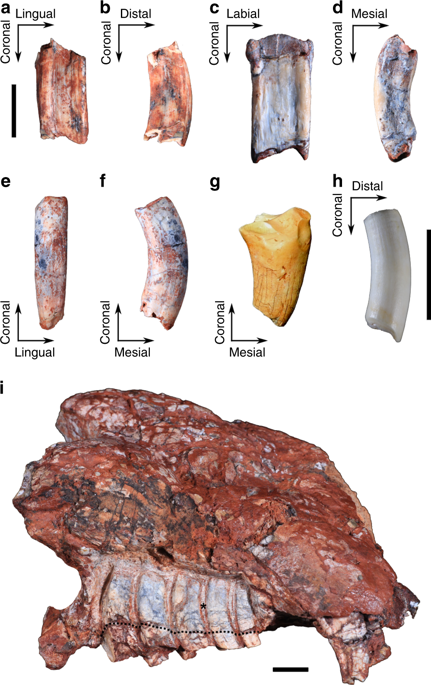Nature Communications ( IF 14.7 ) Pub Date : 2019-06-28 , DOI: 10.1038/s41467-019-10719-7 Tomaz P Melo 1 , Ana Maria Ribeiro 2 , Agustín G Martinelli 3 , Marina Bento Soares 4

|
Hypsodonty, the occurrence of high-crowned teeth, is widespread among mammals with diets rich in abrasive material, such as plants or soil, because it increases the durability of dentitions against wear. Hypsodont postcanine teeth evolved independently in multiple mammalian lineages and in the closely related mammaliaforms since the Jurassic period. Here, we report the oldest record, to our knowledge, of hypsodont postcanines in the non-mammaliaform stem-mammal, Menadon besairiei, from the early Late Triassic. The postcanines are long and columnar, with open roots. They were not replaced in older individuals and remained functional after the total wear of the crown enamel. Dental histology suggests that, convergently to hypsodont mammals, wear was compensated by the prolonged growth of each postcanine, resulting in dentine hypsodont teeth most similar to extant xenarthran mammals. These findings highlight the constraints imposed by limited tooth replacement and tooth wear in the evolutionary trajectories of herbivorous mammals and stem-mammals.
中文翻译:

三叠纪干哺乳动物中磨牙状齿状畸形的早期证据。
高齿牙齿的齿状畸形在饮食中富含磨料的哺乳动物(例如植物或土壤)中很普遍,因为它增加了牙列的耐磨损性。自侏罗纪以来,犬齿后犬牙齿在多种哺乳动物谱系中以及在密切相关的哺乳动物形态中独立进化。在此,据我们所知,我们报告了非哺乳动物类干哺乳动物Menadon besairiei中的假人后齿犬的最古老记录。,来自三叠纪晚期。后犬长而呈柱状,根部开放。它们在年长的个体中没有被替换,并且在冠瓷釉完全磨损后仍保持功能。牙齿的组织学研究表明,与犬齿动物相比,牙齿的磨损可以通过每个犬齿的延长生长来补偿,从而使牙本质犬齿的牙齿与现存的xenarthran哺乳动物最为相似。这些发现突显了草食性哺乳动物和干哺乳动物的进化轨迹中有限的牙齿替换和牙齿磨损所施加的限制。


















































 京公网安备 11010802027423号
京公网安备 11010802027423号